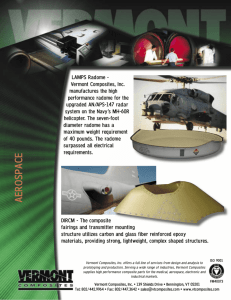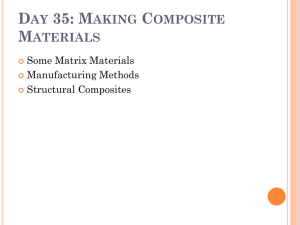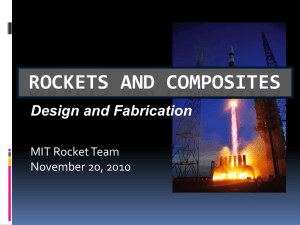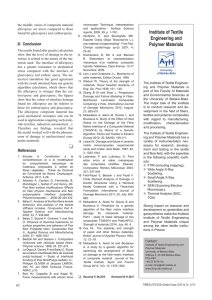Research Journal of Applied Sciences, Engineering and Technology 12(2): 197-205,... DOI:10.19026/rjaset.12.2321
advertisement
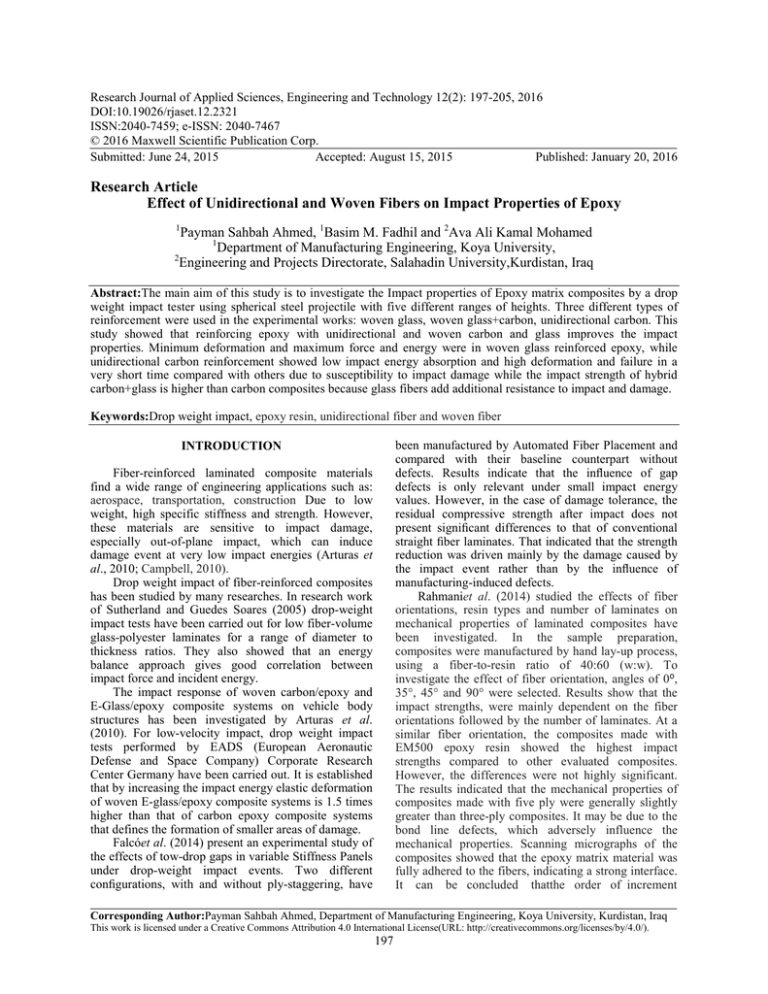
Research Journal of Applied Sciences, Engineering and Technology 12(2): 197-205, 2016 DOI:10.19026/rjaset.12.2321 ISSN:2040-7459; e-ISSN: 2040-7467 © 2016 Maxwell Scientific Publication Corp. Submitted: June 24, 2015 Accepted: August 15, 2015 Published: January 20, 2016 Research Article Effect of Unidirectional and Woven Fibers on Impact Properties of Epoxy 1 Payman Sahbah Ahmed, 1Basim M. Fadhil and 2Ava Ali Kamal Mohamed 1 Department of Manufacturing Engineering, Koya University, 2 Engineering and Projects Directorate, Salahadin University,Kurdistan, Iraq Abstract:The main aim of this study is to investigate the Impact properties of Epoxy matrix composites by a drop weight impact tester using spherical steel projectile with five different ranges of heights. Three different types of reinforcement were used in the experimental works: woven glass, woven glass+carbon, unidirectional carbon. This study showed that reinforcing epoxy with unidirectional and woven carbon and glass improves the impact properties. Minimum deformation and maximum force and energy were in woven glass reinforced epoxy, while unidirectional carbon reinforcement showed low impact energy absorption and high deformation and failure in a very short time compared with others due to susceptibility to impact damage while the impact strength of hybrid carbon+glass is higher than carbon composites because glass fibers add additional resistance to impact and damage. Keywords:Drop weight impact, epoxy resin, unidirectional fiber and woven fiber been manufactured by Automated Fiber Placement and compared with their baseline counterpart without defects. Results indicate that the influence of gap defects is only relevant under small impact energy values. However, in the case of damage tolerance, the residual compressive strength after impact does not present significant differences to that of conventional straight fiber laminates. That indicated that the strength reduction was driven mainly by the damage caused by the impact event rather than by the influence of manufacturing-induced defects. Rahmaniet al. (2014) studied the effects of fiber orientations, resin types and number of laminates on mechanical properties of laminated composites have been investigated. In the sample preparation, composites were manufactured by hand lay-up process, using a fiber-to-resin ratio of 40:60 (w:w). To investigate the effect of fiber orientation, angles of 0⁰, 35°, 45° and 90° were selected. Results show that the impact strengths, were mainly dependent on the fiber orientations followed by the number of laminates. At a similar fiber orientation, the composites made with EM500 epoxy resin showed the highest impact strengths compared to other evaluated composites. However, the differences were not highly significant. The results indicated that the mechanical properties of composites made with five ply were generally slightly greater than three-ply composites. It may be due to the bond line defects, which adversely influence the mechanical properties. Scanning micrographs of the composites showed that the epoxy matrix material was fully adhered to the fibers, indicating a strong interface. It can be concluded thatthe order of increment INTRODUCTION Fiber-reinforced laminated composite materials find a wide range of engineering applications such as: aerospace, transportation, construction Due to low weight, high specific stiffness and strength. However, these materials are sensitive to impact damage, especially out-of-plane impact, which can induce damage event at very low impact energies (Arturas et al., 2010; Campbell, 2010). Drop weight impact of fiber-reinforced composites has been studied by many researches. In research work of Sutherland and Guedes Soares (2005) drop-weight impact tests have been carried out for low fiber-volume glass-polyester laminates for a range of diameter to thickness ratios. They also showed that an energy balance approach gives good correlation between impact force and incident energy. The impact response of woven carbon/epoxy and E-Glass/epoxy composite systems on vehicle body structures has been investigated by Arturas et al. (2010). For low-velocity impact, drop weight impact tests performed by EADS (European Aeronautic Defense and Space Company) Corporate Research Center Germany have been carried out. It is established that by increasing the impact energy elastic deformation of woven E-glass/epoxy composite systems is 1.5 times higher than that of carbon epoxy composite systems that defines the formation of smaller areas of damage. Falcóet al. (2014) present an experimental study of the effects of tow-drop gaps in variable Stiffness Panels under drop-weight impact events. Two different configurations, with and without ply-staggering, have Corresponding Author:Payman Sahbah Ahmed, Department of Manufacturing Engineering, Koya University, Kurdistan, Iraq This work is licensed under a Creative Commons Attribution 4.0 International License(URL: http://creativecommons.org/licenses/by/4.0/). 197 Res. J. App. Sci. Eng. Technol., 12(2): 197-205, 2016 maximum force and energy were in Woven Glass reinforced energy (WG), while unidirectional carbon reinforcement showed low impact energy absorption and high deformation and failure in a very short time compared with others due to susceptibility to impact damage while the impact strength of hybrid carbon + glass is higher than carbon composites because glass fibers add additional resistance to impact and damage. Fig. 1: Samples and molds of the study EXPERIMENTAL PART parameters in the mechanical properties of the composites is fiber orientation >number of laminates >resin type. Raghad (2013) studied the impact strength. For some epoxy composites. epoxy composite was reinforced with carbon fibers (chopped), reinforced with hybrid carbon fibers (chopped) and glass fibers (woven roven) with volume fraction (30)% for each type. The tests were done at room temperature (34±2ºC). In this study the hybrid composite (C+G/Epoxy) have the higher mechanical properties than that composite (C/Epoxy). The results shown that the exists of woven glass fiber increasing the impact strength of hybrid composite in comparison with the composite reinforced with randomly chopped carbon fibers. The results of impact strength for (C/epoxy) are smaller than the results of (C+G/epoxy), because of carbon fibers have brittle characteristics, while glass fibers have resistance to impact and damage. Sunith Babu and Shivanand (2014) focused on investigating the impact property of laminated composites. The behavior of E-glass/epoxy and carbon fiber laminated composite plates has been experimentally studied under impact of steel projectile at low velocities. The results were obtained using a drop weight impact machine and presented for crossply laminates [0 - 90] combination. The experimental test series showed an increased deflection for glass composite plates, which lead to a higher extent of material damage compared to the carbon fiber, laminates plates with de laminations as one important energy absorption mechanism. From the above result cfrp has more strength then gfrp. Kaleemullaand Siddeswarappa (2009) presented the fracture behaviour and failure mechanisms of composite laminates containing woven-glass-fabric under impact loading. This study showed that reinforcing epoxy with unidirectional and woven carbon and glass improves the impact properties. Minimum deformation and Table 1: Prepared samples for the study No. Matrix Composites symbol 1 Epoxy Epoxy 2 WGC 3 WG 4 UC In this research Hand lay-up molding technique is used in preparing composites. The composite was made using a glass mold as can be seen in Fig. 1. The composite was prepared with one volume fraction of (20% Vf) for all samples as listed in Table 1. The ratio of epoxy to hardener is (73% to 27%), every 4gm from transparent epoxy resin was mixed with 1.47 gm of hardener. The molds were left for 3 weeks to be cured at room temperature. To determine the mechanism of impact damage the experiment was performed when composite materials were deformed with different impactors in an Instron Ceast 9350 impact tester instrumented drop-weight tower by an automatic anti-rebound impactor system (Fig. 2a). The unsupported area of the specimen during the impact is 125 mm by 75 mm. The data recorded are the history of the impactor force, energy, displacement and velocity where the impactor moved down at a specific velocity Special impact equipment consisting of vertically falling impactor and was used in the test (Fig. 2). RESULTS AND DISCUSSION During the test when the impact energy was increased by increasing impact falling height the relationships of force-time, force-deformation, forceenergy and energy-time were obtained from experimental data as follows: Impact force-time behavior: Figure 3 shows the impact force-time results of the composites used in this study when deformed from impact falling heights: 600, 700, 800, 900 and 1000 mm, where it can be see the minimum force were in the epoxy without any reinforcement and maximum force were in Woven Glass reinforced energy (WG) these results agree with Bajpai et al. (2002) they found that the samples Weight fraction of Matrix wtm% 100 80 80 80 198 Fibers Woven Carbon+Glass Woven Glass Unidirectional Carbon Weight fraction of fibers Wtf% 0 20 20 20 Res. J. App. Sci. Eng. Technol., 12(2): 197-205, 2016 Fig. 2: Impact tester machine 199 Res. J. App. Sci. Eng. Technol., 12(2): 197-205, 2016 600 mm 12000 WGC WG Epoxy UC 12000 10000 8000 Force N Force N 10000 700 mm WGC WG Epoxy UC 6000 8000 6000 4000 4000 2000 2000 0 0 1.5 3.5 -2000 7.5 5.5 Time ms 1.5 3.5 -2000 WGC WG Epoxy UC WGC WG Epoxy UC 8000 7000 6000 8000 Force N Force N 10000 7.5 900 mm 800 mm 12000 5.5 Time ms 6000 5000 4000 3000 4000 2000 2000 1000 0 0 1.5 -2000 3.5 7.5 5.5 Time ms 1.5 3.5 -1000 5.5 Time ms 7.5 1000 mm 10000 Force N 8000 WGC WG Epoxy 6000 4000 2000 0 1.5 3.5 -2000 5.5 Time ms 7.5 9.5 Fig. 3: Force-time relationship of the composites used in this study from impact falling heights: 600, 700, 800, 900 and 1000 mm reinforced with e-glass fibers which have good ability to absorb large share of impact stresses due to nature of fabric in two directions (Raghad, 2013; Bajpai et al., 2002; Saadet al., 2014). It is noted that as the impact energies increase, the force time curves become sharper with faster load drops i.e., higher falling heights loads and this agrees with Sohn et al. (2000). UC composites showed low impact force and crack propagates rapidly in a very short time compared with others due to susceptibility to impact damage because of the brittle characteristics of the reinforced fibers in addition to non-isotropic behavior of the unidirectional fibers which are considered as a weakness in the composite’s structure, With increasing impact energy the damage involves more matrix cracking and splits along the UC fiber direction while the impact strength of hybrid (carbon + glass) WGC is higher than carbon composites because glass fibers added additional resistance to impact and damage (Raghad, 2013). With increasing the falling heights the force value increase then decrease to zero faster due to strong impact effect where we can see the time in 1000 mm height the force reaches to zero within 5 ms compared to 6, 6.5, 8 and 8 ms in 900, 800, 700 and 600 mm height respectively. 200 Res. J. App. Sci. Eng. Technol., 12(2): 197-205, 2016 600 mm 12000 10000 10000 8000 6000 8000 6000 4000 4000 2000 2000 0 -2000 WGC WG Epoxy UC 12000 Force N Force N 700 mm WGC WG Epoxy UC 0 5 0 10 Deformation mm 15 20 -2000 5 0 10 Deformation mm 800 mm 8000 7000 6000 8000 Force N Force N 10000 20 900 mm WGC WG Epoxy UC 12000 15 6000 4000 WGC WG Epoxy UC 5000 4000 3000 2000 2000 1000 0 -2000 0 0 5 15 10 Deformation mm 20 25 -5 5 -1000 0 15 10 Deformation mm 20 25 1000 mm 10000 Force N 8000 6000 WGC WG Epoxy UC 4000 2000 0 0 -2000 5 20 10 15 Deformation mm 25 30 Fig. 4: Force-deformation relationship of the composites used in this study from impact falling heights: 600, 700, 800, 900 and 1000 mm part of impact energy absorbed with the composite of WG followed by WGC, UC. Epoxy without any reinforcement was the lowest. With reference to great frequency relationships during the tests the conclusion can be made that the structure delaminated because of local damage. At the greatest impact energy provided on the specimen during the test characteristics show the initial processes of the sample perforation. But when low energy impacts are used for deformation the specimen is not fully perforated in all instances when WG, WGC and UC composites were used (Arturas et al., 2010). Impact force-deformation behavior: Figure 4 shows the impact force-deformation results of the composites used in this study when deformed from impact falling heights of 600, 700, 800, 900 and 1000 mm, where it can be see the following: behavior of all composites during the impact (Fig. 4) showed that the most important peculiarity of these composite materials was decreasing stiffness when the displacement increased due to great specimen deflection related with non-linear membrane effect (Arturas et al., 2010). But the area underthe force-displacement curve showed the great 201 Res. J. App. Sci. Eng. Technol., 12(2): 197-205, 2016 700 mm 600 mm 40 WGC WG Epoxy UC WGC WG Epoxy UC 40 Energy J 30 Energy J 50 20 30 20 10 10 0 0 10 5 Time ms -10 0 5 Time ms 0 -10 800 mm 60 WGC WG Epoxy UC 40 Energy J Energy J 900 mm 60 WGC WG Epoxy UC 40 20 20 0 0 0 -20 10 10 5 Time ms 0 -20 5 Time ms 10 1000 mm 80 WGC WG Epoxy UC Energy J 60 40 20 0 0 5 Time ms 10 Fig. 5: Energy-time relationship of the composites used in this study from impact falling heights: 600, 700, 800, 900 and 1000 mm Due to rather significant duration of impact contact during the deformation with low energy impacts when the impactor struck against the specimens of WG, WGC and UC, the composite absorbed the impact energy after the impact and was encountered with elastic deformation that was less than necessary for the breakdown (Arturas et al., 2010). Figure 4 shows that the WG composites had a special behavior at impact heights 600 and 700 mm, where both force and deformation is increase and decreases (Basim, 2013) again due to the transformation of potential energy to kinetic energy. But when the impact energy is greater i.e. 800 to 1000 mm, the force value increase and decrease with the continuous increase in the deformation until failure. Unlike WG composite specimens the UC composites specimens show a very low force and deformation values before failure and this is explained as the abrupt decrease of stiffness after matrix cracking and splits along the (UC) fiber direction and fracture. WGC composites showed a decreasing stiffness when the displacement increased due to great specimen deflection and perforation (Vieille et al., 2013) in all impact falling heights. Impact energy-time behavior: Figure 5 shows the Energy-time relationships of the composites used in 202 Res. J. App. Sci. Eng. Technol., 12(2): 197-205, 2016 showed low impact energy absorption and failure in a very short time compared with others due to susceptibility to impact damage because of the brittle characteristics of the reinforced fibers in addition to non-isotropic behavior of the unidirectional fibers which are considered as a weakness in the composite structure while the impact strength of hybrid carbon +glass is higher than carbon composites because glass fibers added additional resistance to impact and damage (Raghad, 2013). thisstudy when the composites deformed from impact falling heights: 600, 700, 800, 900 and 1000 mm. Just like the impact force results, results of 600 mm impact height showed that the minimum energy were in the epoxy without any reinforcement and the maximum energy were in Woven Glass reinforced energy (WG) due to E-glass fibers which have good ability to absorb large share kinetic energy so fibers role should be crack stopper (Raghad, 2013; Bajpai et al., 2002; Saadet al., 2014), whileunidirectionalcarbonreinforcement 600 mm 700 mm 40 WGC WG Epoxy UC 35 WGC WG Epoxy UC 40 35 25 Energy J Energy J 30 45 20 15 30 25 20 10 15 5 10 5 00 0 -5 5 10 Deformation mm 20 15 0 -5 5 0 10 Deformation mm 900 mm 800 mm 60 40 30 40 30 20 20 10 10 0 0 -10 5 WGC WG Epoxy UC 50 Energy J 50 Energy J 60 WGC WG Epoxy UC 15 10 0 20 25 10 5 0 -5 -10 Deformation mm 20 15 15 20 25 Deformation mm 1000 mm 70 WGC WG Epoxy UC 60 Energy J 50 40 30 20 10 0 0 5 10 20 15 Deformation mm 25 30 Fig. 6: Energy-deformation relationship of the composites used in this study from impact falling heights: 600, 700, 800, 900 and 1000 mm 203 Res. J. App. Sci. Eng. Technol., 12(2): 197-205, 2016 At 700 mm falling height, (WG) composite has a different energy-time behavior compared with that of 600 mm falling weight where in the case of 600 mm the energy reaches its maximum value at the middle of the test and decreased after that to the end of the test while in 700 mm the energy had no time to decrease only for a little extent due to the higher falling height. (UC) composite had the same behavior in both falling heights having a very weak energy behavior. (WGC) composite also had the same behavior in both heights where the energy keeps in increasing to the end of the test. At higher falling heights, energy keeps in increasing until it reaches its maximum value at 1000 mm in WG composites. • absorption and high deformation and failure in a very short time compared with others due to susceptibility to impact damage because of the brittle characteristics of the reinforced fibers in addition to non-isotropic behavior of the unidirectional fibers which are considered as a weakness in the composite structure while the impact strength of hybrid carbon+glass is higher than carbon composites because glass fibers added additional resistance to impact and damage. For all the laminate specimens, the time to reach the maximum load s is shorter at higher impact heights i.e. high impact energies. REFERENCES Impact energy-deformation behavior: Figure 6 shows the Energy- Deformation relationships of the composites used in this study when the composites deformed from impact falling heights: 600, 700, 800, 900 and 1000 mm. Figure 6 shows that the WG composites had a special behavior at impact heights 600 and 700 mm, where both energy and deformation is increase and decreases (Basim, 2013) again due to the transformation of potential energy to kinetic energy. But when the impact energy is greater 800 to 1000 mm, the force value increase continuously until failure in perforation mode and fracture (Vieille et al., 2013). WGC composites showed an increasing energy when the displacement increased due to great specimen deflection and perforation (Vieille et al., 2013) in all impact falling heights until fracture. UC composites showed low impact energy and crack propagates rapidly in a very little deformation compared with others due to susceptibility to impact damage because of the brittle characteristics of the reinforced fibers in addition to non-isotropic behavior of the unidirectional fibers which are considered as a weakness in the composite’s structure, With increasing impact energy the damage involves more matrix cracking and splits along the (UC) fibre direction. Epoxy without any reinforcement showed a very low absorbed energy with a very large deformation in all impact falling heights compared with the other composites. Arturas, K., K. Neringa and Z. Antanas, 2010. Experimental research of the impact response of eglass/epoxy and carbon/epoxy composite systems. Mater. Sci., 16(4): 324-329. Bajpai, R., V. Mishra, P. Agrawal and S.C. Datt, 2002. Surface modification on PMMA: PVDF polyblend: Hardeningunder chemical environment. B. Mater. Sci., 25(1): 21-23. Basim, M.F., 2013. Effect of plies stacking sequence and tube geometry on the crush behavior of tube under low velocity impact-numerical study. Int. J. Mech. Appl., 3(2): 44-51. Campbell, F.C., 2010. Structural Composite Materials. ASM International. Retrieved from: www.asminternational.org. Falcó, O., C.S. Lopes, J.A. Mayugo, N. Gascons and J. Renart, 2014. Effect of tow-drop gaps on the damage resistance and tolerance of variablestiffness panels. Compos. Struct., 116: 94-103. Kaleemulla, K.M.and B. Siddeswarappa, 2009. Damage characteristics of fabric reinforced hybrid composite laminates subjected to low energy impacts. Int. J. Mater. Prod. Technol., 34: 303-311. Raghad, H.M., 2013. Study the effect of glass fibers on mechanical properties of epoxy composites. Eng. Tech. J., 31(5): 653-659. Rahmani, H., S. Heydar Mahmoudi Najafi and A. Ashori, 2014. Mechanical performance of epoxy/carbon fiber laminated composites. J. Reinf. Plast. Comp., 33(8): 733-740. Saad, N.A., M.S. Hamzah and A.F. Hamzah, 2014. Experimental and Numerical Simulation of Impact Fracture Toughness of Polyphenylene Sulfide Basis Composite Material. Repository of Open Access Papers, University of Babylon Library, pp: 1-14. Sohn, M.S., X.Z. Hu, J.K. Kim and L. Walker, 2000. Impact damage characterization of carbon fiber/epoxy composites with multi-layer reinforcement. Compos. Part B-Eng., 31: 681-691. CONCLUSION • This study showed that reinforcing epoxy with unidirectional and woven carbon and glass improves the impact properties. Minimum deformation and maximum force and energy were in Woven Glass reinforced energy (WG), samples reinforced with e-glass fibers which have good ability to absorb large share of impact stresses and kinetic energy, while unidirectional carbon reinforcement showed low impact energy 204 Res. J. App. Sci. Eng. Technol., 12(2): 197-205, 2016 Vieille, B., V.M. Casado and C. Bouvet, 2013. About the impact behavior of woven-ply carbon fiber reinforced thermoplastic- and thermosettingcomposites: A comparative study. Compos. Struct., 101: 9-21. Sunith Babu, L. and H.K. Shivanand, 2014. Impact analysis of laminated composite on glass fiber and carbon fiber. Int. J. Emerg. Technol. Adv. Eng., 4(6): 824-829. Sutherland, L.S. and C. Guedes Soares, 2005. Impact characterisation of low fibre-volume glass reinforced polyester, circular laminated plates. Int. J. Impact Eng., 31: 1-23. 205
